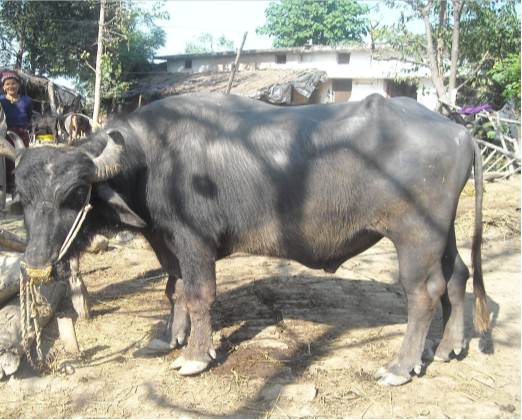Tarai
- Origin & Breeding Tract
- Population
- Physical Characteristics
- Morphological Characteristics
- Performance Record
- Management Practices
- Housing System
- Feeding System
- Breeding System
- Calf Management
- Conservation of Breed
- Socio-economic impact
Some of the important characteristics is described as follows: –
| Body color | Grayish brown to black coat colour on black skin. Eyelids, hooves, nose ridge, face and pastern joint are mostly black in 89 to 95% cases. | |
| Horns | Orientation of horns is mostly backward (76%) and black in color. Shape of horn is slightly curved to sickle shape (76%) measuring 44 cm with tip projecting mostly upward (72%). Horns are smaller in females (32 cm) than males (44 cm.). | |
| Marking | ||
| Eye | ||
| Tail | Slightly lower than hock joint measuring 89 to 99 cm. Switch of the tail is mostly white. | |
| Body | Medium, compact with small, straight and shining hair.Navel is tight and sheath is non pendulous. | |
| Head | Short in length, convex (60%) or flat (35%) in shape | |
| Face | ||
| Neck | Strong neck of 63 to 66 cm long in female and 70 to 71 cm long in males. | |
| Ear | Orientation of ear is backward and comparatively small in size. | |
| Limbs | ||
| Skin | ||
| Udder | Shape of udder is mostly round (56%) and rarely pendulous. Fore udder is either flat (31%) or projected (45%) when filled with milk. Rear udder is small. | |
| Teats | 46% of teats are small with pointed tips. |
Fat per cent of milk was recorded from records of the primary milk collection society where farmer was supplying the milk.
(a) Monthly milk yield: Milk yield on day of recording multiplied by 30 was taken as monthly milk yield. Average milk yield during first month of first lactation was 127.07±4.18kg. while during second lactation it was 125.86±3.39 kg. during second month. Milk yield progressively decline from third month to 12th month of lactation.
(b) Lactation milk yield: Average first lactation milk yield recorded as 1030.04±26.78 kg while that in second lactation it was 1080.09±28.58 kg. Thus, there was an increase in milk production by 4.86% during second lactation over first lactation. Over all average milk yield in both lactations was 1054.08±1957 kg.
(c) Fat Percent: Fat per cent recorded during first lactation was 6.35±0.11 per cent while in second lactation it was 6.67±0.14 with over all fat per cent of 6.58±0.09%. The coefficient of variation observed was between 13.71 to 16.63 per cent.
(d) SNF content: Average SNF calculated during first lactation was 8.56±0.08 per cent while 8.59±0.02 during second lactation. The overall SNF content was 8.57±0.05 based on 47 samples.
(e) Lactation length: Seventy nine per cent of buffaloes completed lactation up to 9 months while only 12.6% of buffaloes remained in lactating upto one year period. Average lactation length was 290.00±4.97 days during first and 292.48±5.32 days during second lactation. The overall lactation length was recorded as 291.19±3.63 days.
.
Reproduction Performance
(a) Service Period: Based on sample of 201 buffaloes, service period in Tarai buffalo was recorded 197.07±6.59 days with 47.45% coefficient of variation.
(b) Dry Period: Dry period was observed as 186.92±16.77 days with 46.62 per cent coefficient of variation.
(c) Calving interval: Average calving interval noted under the recording period was 470.62±18.07 days with 19.95 per cent coefficient of variation.
(i) Ten thousand Five hundred Ninety (10,590) doses of DFS of Tarai buffalo were prepared and supplied to NBAGR, Karnal.
(ii) Twenty Eight (28) Tarai buffalo bulls maintained under the project were transferred to U.S. Nagar Dugdha Utpadak Sahakari Sangh Ltd., Rudrapur for distribution to different milking societies for use in breeding and improvement of Tarai buffaloes.
Breeding Policy for Buffalo in Uttarakhand
| Name of the Zone | Breeding Policy | Remarks |
| Zone A: upto 1000 m Altitude:
Tropical Zone: Plains, Terai, Bhavar, Shivalik & Vallies |
Grading up with pure Murrah semen. | Policy universal for buffalo state wide |
| Zone B: 1000 – 1500 m Altitude:
Subtropical Zone |
Grading up with pure Murrah semen. | Policy universal for buffalo state wide |
| Zone C: 1500 – 2400 m Altitude:
Cool Temperate Zone |
Grading up with pure Murrah semen. | Policy universal for buffalo state wide |
| Zone D: Above 2400 m Altitude:
Sub-Alpine Zone |
Grading up with pure Murrah semen. | Policy universal for buffalo state wide |
contributed by CV singh and RS Barwal

